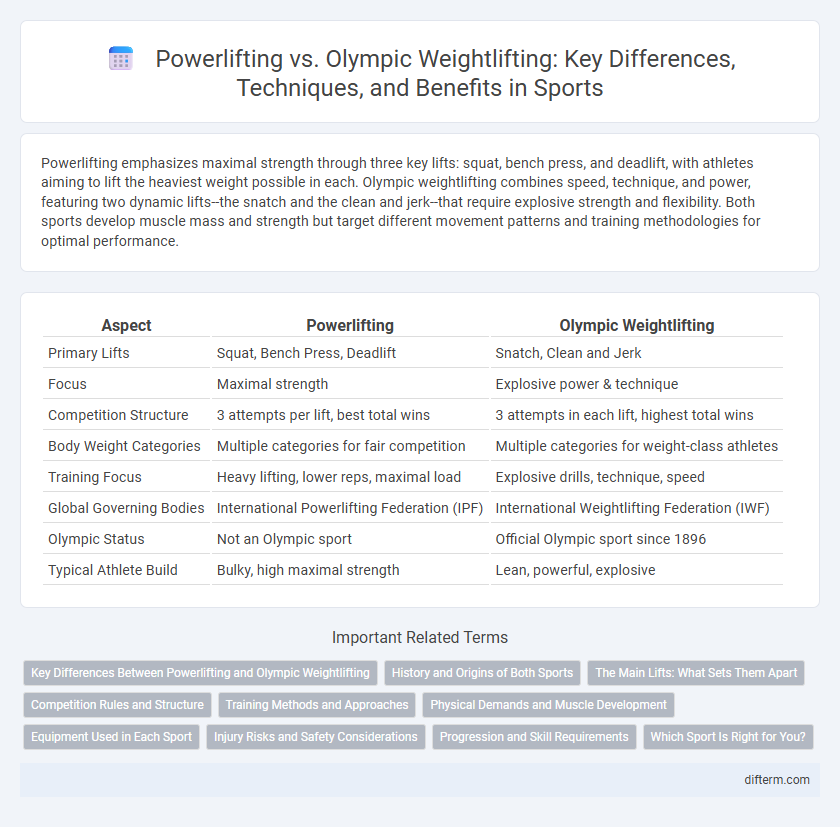Powerlifting emphasizes maximal strength through three key lifts: squat, bench press, and deadlift, with athletes aiming to lift the heaviest weight possible in each. Olympic weightlifting combines speed, technique, and power, featuring two dynamic lifts--the snatch and the clean and jerk--that require explosive strength and flexibility. Both sports develop muscle mass and strength but target different movement patterns and training methodologies for optimal performance.
Table of Comparison
| Aspect | Powerlifting | Olympic Weightlifting |
|---|---|---|
| Primary Lifts | Squat, Bench Press, Deadlift | Snatch, Clean and Jerk |
| Focus | Maximal strength | Explosive power & technique |
| Competition Structure | 3 attempts per lift, best total wins | 3 attempts in each lift, highest total wins |
| Body Weight Categories | Multiple categories for fair competition | Multiple categories for weight-class athletes |
| Training Focus | Heavy lifting, lower reps, maximal load | Explosive drills, technique, speed |
| Global Governing Bodies | International Powerlifting Federation (IPF) | International Weightlifting Federation (IWF) |
| Olympic Status | Not an Olympic sport | Official Olympic sport since 1896 |
| Typical Athlete Build | Bulky, high maximal strength | Lean, powerful, explosive |
Key Differences Between Powerlifting and Olympic Weightlifting
Powerlifting centers on maximal strength demonstrated through three main lifts: squat, bench press, and deadlift, emphasizing absolute power with lower repetition ranges. Olympic weightlifting involves two dynamic lifts--the snatch and the clean and jerk--requiring explosive power, speed, and technique to lift a single maximum effort overhead. The sport-specific training and competition rules highlight powerlifting's focus on pure strength, whereas Olympic weightlifting prioritizes athleticism, coordination, and mobility.
History and Origins of Both Sports
Powerlifting originated in the mid-20th century as a test of maximal strength across three lifts: squat, bench press, and deadlift, gaining popularity in the United States during the 1950s. Olympic weightlifting, with roots tracing back to ancient Greece and formalized in the 1896 Olympic Games, centers on the snatch and clean and jerk lifts, emphasizing explosive power and technique. Both sports evolved distinctly, with powerlifting focusing on raw strength and Olympic weightlifting prioritizing speed, agility, and coordination.
The Main Lifts: What Sets Them Apart
Powerlifting centers on the squat, bench press, and deadlift, emphasizing maximal strength in single, controlled movements. Olympic weightlifting consists of the snatch and the clean and jerk, demanding explosive power, speed, and technique to lift the barbell overhead in dynamic, full-body lifts. The fundamental difference lies in the execution and purpose: powerlifting tests raw strength, while Olympic weightlifting combines strength with agility and coordination.
Competition Rules and Structure
Powerlifting competitions consist of three attempts in the squat, bench press, and deadlift, with the highest successful lift in each contributing to the athlete's total score. Olympic weightlifting includes the snatch and the clean and jerk, where athletes have three attempts in each lift, and the combined total determines the winner. Both sports have strict rules on technique and equipment, but Olympic weightlifting requires more dynamic movement and explosive power, while powerlifting emphasizes maximal strength in slower, controlled lifts.
Training Methods and Approaches
Powerlifting training emphasizes maximal strength development through low-repetition sets focusing on the squat, bench press, and deadlift, using progressive overload and periodization to optimize peak performance. Olympic weightlifting incorporates explosive power, speed, and technique refinement with dynamic lifts like the snatch and clean and jerk, prioritizing mobility, coordination, and bar path efficiency. Both disciplines use complementary accessory exercises but differ significantly in neuromuscular activation patterns and conditioning priorities.
Physical Demands and Muscle Development
Powerlifting emphasizes maximal strength in the squat, bench press, and deadlift, targeting hypertrophy primarily in the quadriceps, gluteus maximus, pectorals, and spinal erectors. Olympic weightlifting requires explosive power and coordination in the snatch and clean & jerk, engaging fast-twitch muscle fibers in the hips, shoulders, and core for rapid force production. The distinct neuromuscular recruitment patterns in each sport lead to specialized muscle development suited to either maximal force output or dynamic, multi-joint explosive movements.
Equipment Used in Each Sport
Powerlifting requires specialized equipment such as squat suits, bench shirts, deadlift suits, and lifting belts to provide support during the squat, bench press, and deadlift lifts. Olympic weightlifting utilizes weightlifting shoes with elevated heels for improved squatting technique, lifting belts, wrist wraps, and sometimes knee sleeves to aid in the snatch and clean and jerk movements. Barbells and bumper plates designed to withstand high-impact drops are essential in Olympic weightlifting, while powerlifting bars are typically stiffer with specific knurling patterns to accommodate heavy lifts.
Injury Risks and Safety Considerations
Powerlifting primarily stresses the back, knees, and shoulders due to heavy, low-rep maximal lifts like the squat, bench press, and deadlift, increasing risk of joint and muscle strain. Olympic weightlifting involves dynamic, explosive movements such as the snatch and clean and jerk, which demand high technique precision to prevent injuries like wrist sprains, shoulder dislocations, and lower back strains. Proper technique, progressive training, and adequate recovery are essential in both sports to minimize injury risks and enhance long-term safety for athletes.
Progression and Skill Requirements
Powerlifting emphasizes maximal strength in three lifts--squat, bench press, and deadlift--requiring progressive overload and consistent strength gains over time. Olympic weightlifting demands high levels of technique, speed, and coordination to execute the snatch and clean & jerk with precision, making skill development crucial alongside strength progression. Athletes often experience longer skill acquisition phases in Olympic lifting, while powerlifting progression centers more on incremental strength improvements.
Which Sport Is Right for You?
Powerlifting emphasizes maximal strength through three lifts: squat, bench press, and deadlift, making it ideal for those focused on raw power and simple technique. Olympic weightlifting requires explosive power and agility with the snatch and clean & jerk, appealing to athletes seeking dynamic movement and full-body coordination. Choosing between powerlifting and Olympic weightlifting depends on your fitness goals, preferred training style, and interest in technical skill development.
powerlifting vs Olympic weightlifting Infographic

 difterm.com
difterm.com